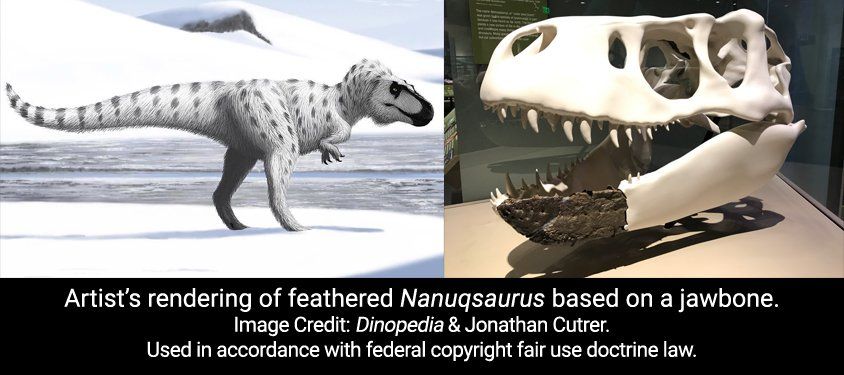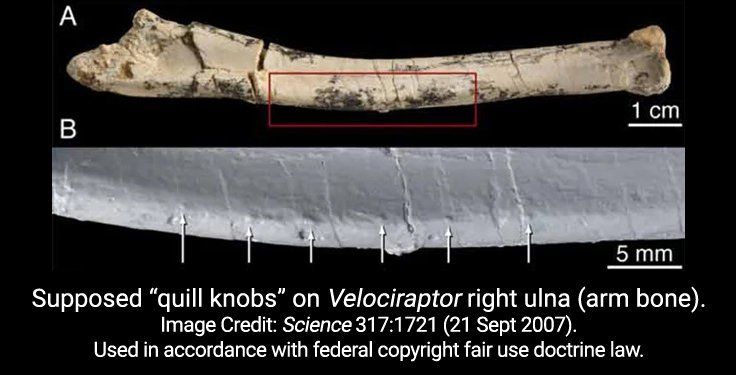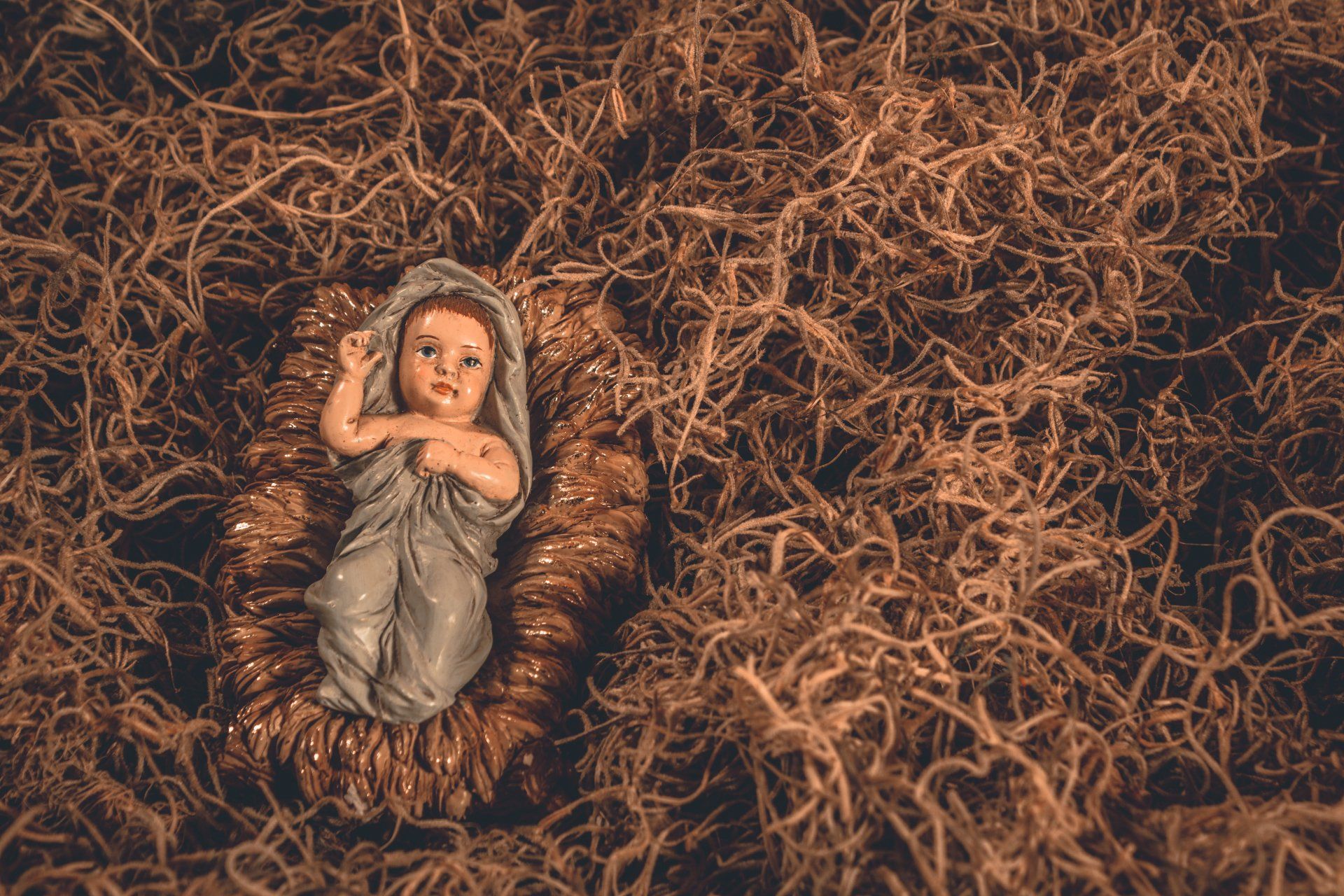Believing in Feather Tales, part 3
Believing in Feather Tales, part 3
Last time in “Believing in Feather Tales”, the idea of dinosaurs being warm-blooded for the simple sake of them being related to birds found zero support in the fossil record.¹ This, however, has not deterred the feathered-dino proponents. Rather, they place all their faith in the belief that some dinosaurs had feathers, making them the evolutionary ancestors of modern birds.
Have there ever been any feathered dinosaurs discovered in the fossil record? NO. Despite this fact, we at Creation Truth Foundation encounter young people at pretty much every event who have been taught and now believe that dinosaurs had feathers, are related to birds, and the Biblical record of Genesis 1 is not true because of the belief in feathered dinosaurs.
Once such example was a young man at a VBS in Barnsdall, OK. He shared how he had learned of
Nanuqsaurus, which was supposedly covered with a double layer of down to keep it warm in Alaska. I invited him to look with me as to what was actually discovered. Together we found that all the paleontologists had discovered were 3 pieces of a skull, and guess how many of them had any feathers or down – zero.² The young man had been told a lie, plain and simple. In fact, the sad reality is that many of the portrayed dinosaurs in media and museums are based on a single fossil, yet entire species are named from one bone for the sake of a paleontologist’s popularity.³

In 2016, a 3.6 cm piece of amber with a feathered tail was once trumpeted as a feathered dinosaur tail, but it has since been peer-reviewed and rarely if ever presented as evidence.⁴
In 2007, media outlets exploded with news that feather quill knobs had been discovered on a
Velociraptor
arm bone. Quill knobs (ulnar papillae) are strong anchor points on the ulna for the attachment of pennaceous flight feathers. Thus, quill knobs are found ONLY on the arms of FLYING birds. Two major problems arose with the announcement of the
Velociraptor
arm bumps as quill knobs:
1. The supposed quill knobs were on the outside of the arm, not on the end of the arm, which is how it is on all living birds with quill knobs.
2. Since quill knobs are found ONLY on FLYING birds, do paleontologists now believe
Velociraptors
could fly?

For the first problem, it is simply ignored. For the second problem, the feather believers say that Velociraptor inherited the quill knobs from an ancestor that used to fly, meaning Velociraptor was a flightless bird with quill knobs.⁵ Really?!?! For one, why have there never been any other flightless birds found with quill knobs? But secondly, how does this prove that birds are descendants of feathered dinosaurs?!?! This argument is the exact opposite of what they are trying to prove! Rather, many evolutionary and creation scientists believe the supposed knobs were points of tendon attachments, seen even on mammal bones.⁶
Fossil specimens with preserved collagen (which cannot last millions of years, showing dinosaurs to have lived and died only thousands of years ago) have been revealed by several scientists to be integumentary fibers, not feathers, formed when the dinosaur was buried and began decomposing before the mud solidified and the animal was fossilized (during the Flood).⁷ In fact, if one is going to believe the preserved collagen remains are feathers, then one has to also believe that the collagen remains of lizards, turtles, snakes, crocodiles, dolphins, and mammoths are also feathers.⁸
Additionally, the feather faithful are dealt a severe blow when it is understood that actual bird fossils are found deeper in rock layers than their supposed dinosaurian ancestors! For example, while
Velociraptor’s evolutionary dates are around 70-74 million years ago (upper Cretaceous), the bird
Anchiornis’s evolutionary dates are around 160 million years ago (upper Jurassic) and the bird
Protoavis’s dates are around 210 million years ago (upper Triassic).⁹ How then are theropod dinosaurs (like
Velociraptor) supposed to be the evolutionary ancestors to birds when birds with full flight capability are found buried in rock layers BELOW dinosaurs?
The science continues to declare that God’s Word is true, including Genesis 1 and its affirmative account that winged creatures were created by the Lord on the 5th day of history and dinosaurs were part of the land creatures created on day 6.
As Jesus said in John 17:17, “Thy Word is truth.”
- Another part of dinosaur anatomy that refutes endothermy (warm-bloodedness) are the supratemporal fenestrae (holes) on the tops of their heads. These fenestrae have been shown to regulate reptiles’ temperatures due to their ectothermy (cold-bloodedness). See: The Anatomical Record July 1, 2019 article “The Frontoparietal Fossa and Dorsotemporal Fenestra of Archosaurs and Their Significance for interpretations of Vascular and Muscular Anatomy in Dinosaurs”, <https://doi.org/10.1002/ar.24218>.
- Anthony R. Fiorillo and Ronald S. Tykoski, “A Diminutive New Tyrannosaur from the Top of the World”, PLoS One, 12 March 2014; 9(3): e912887, <10.1371/journal.pone.0091287>.
- 0.0025% of the fossil record is comprised of vertebrates with more than one bone. See: Dr. Andrew A. Snelling, “Where Are All the Human Fossils?”, Creation14, no 1 (Dec. 1991): 28-33.
- Dr. Frank Sherwin, “Another Feathered Dinosaur Tale”, 10 September 2016, <https://www.icr.org/article/another-feathered-dinosaur-tale>.
Calvin Smith, “Feathered forerunner or flight of fancy?”, 14 January 2017, < https://creation.com/feathered-forerunner-or-flight-of-fancy>. - “…ulnar papillar reduction or absence in large-bodied derived dromaeosaurids reflects loss of aerodynamic capabilities from the clade’s ancestral members.” – Alan Turner, et. al., “Feather Quill Knobs in the Dinosaur Velociraptor”, Science, 21 Sep. 2007, Vol. 317, No. 5845, p. 1721.
- “…animals sometimes have weird, irregularly spaced tubercles arranged in lines on various of their bones, typically located on intermuscular lines (they presumably represent partially ossified attachment sites for tendinous sheets or similar structures): I’ve seen them on mammal bones and on a theropod tibia…”. - Dr. Darren Naish, “Concavenator: an incredible allosaurid with a weird sail (or hump)… and proto feathers”, scienceblogs.com, 9 September 2010, <http://scienceblogs.com/tetrapodzoology/2010/09/09/concavenator-incredible-allosauroid/>.
See also: Foth & Rauhut, The Evolution of Feathers (Springer, 2020). - Feduccia, Lingham-Soliar, & Hinchliffe (2005), “Do Feathered Dinosaurs Exist?”, Journal of Morphology 266(2):125-166.
- Dr. Alan Feduccia, Romancing the Birds and Dinosaurs, Brown Walker Press, Irvine, CA, 2020, pp. 182-7.
- Fossil Wiki and Natural History Museum in London


